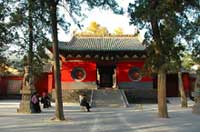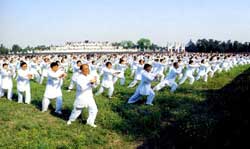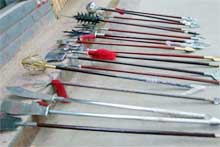Martial arts, known abroad as kungfu, are part of China's traditional culture. Historically, martial arts were developed for self-defense and survival. The most effective methods and useful techniques were recorded and passed down from one generation to another.
During the Han Dynasty (206 BC -220 AD) , competitions in various forms further promoted the development of martial arts. By the Tang Dynasty (618-907) , one of the most powerful periods in China's history, warriors were chosen and officers promoted through martial arts competitions. Chinese martial arts became widely known among China's neighbors and were called "tangshou dao," literally the "way of the Chinese hand."
 In the early years of the Tang Dynasty, the Shaolin monks helped Li Shimin (Emperor 'Iai Zong) conquer his enemies. To show his gratitude, the emperor gave the temple special permission to train monks in martial arts, and the Quan style of martial arts practiced at the Shaolin Temple became very popular.
In the early years of the Tang Dynasty, the Shaolin monks helped Li Shimin (Emperor 'Iai Zong) conquer his enemies. To show his gratitude, the emperor gave the temple special permission to train monks in martial arts, and the Quan style of martial arts practiced at the Shaolin Temple became very popular.
In the Ming (1368-644) and Qing (1644-911) Dynasties, various Quan schools were set up, each named after its master. The Qing government strictly restricted martial arts practice, hoping to maintain its position of control, but it still spread among the general public. Many popular schools of Quan styles including Taiji Quan, Nan Quan, and Xingyi Quan were established and each had its own guiding theories. Various forms of martial arts became established in Korea, Japan and other countries.
Contemporary martial arts are practiced by many people for the benefit to their health. In many big cities, particularly in the early mornings, one can see groups of enthusiasts practicing their chosen art form. People in rural areas practice martial arts, not only in the mornings and evenings, but also during breaks from work in the fields. Many farmers like to watch martial arts contests, and young villagers usually know the fundamentals of the routines.
Forms and Classifications of Martial arts
It is not an easy task to classify Chinese Martial arts because of the number and variety of styles. Generally, martial arts can be classified by one of the following three styles:
(1) Southern or northern
The first method is mainly based on the geographical region of origin or development. Basically, the Yellow River serves as the dividing line between these two styles. Practitioners of the southern style shout to make their movements more forceful. The Northern style is characterized by its short, swift and vigorous movements.
(2) Internal and external
The difference between the internal and the external style refers to whether the strength is from the torso and legs (internal) or whether the strength is derived from specific arm and leg muscles (external). Internal is a more flexible martial arts style. Some people maintain that martial arts styles are either exclusively hard (external) or exclusively soft (internal). This is incorrect. Any good style of martial arts combines both the internal and external principles, and no style is purely internal or external.
 (3) Shaolin, Wudang or Emei
(3) Shaolin, Wudang or Emei
The Shaolin Quan style comes from the form of fighting practiced at the Shaolin Temple in Henan Province. Wudang is the name of a mountain inhabited by Daoists in Hubei Province and Emei is a mountain of religious significance in Sichuang Province.
Aside from general classification, modern martial arts also fall into two forms.
1) Barehanded Competition
Barehanded competition describes the performance of a sequence, usually traditional, demonstrating the function and essence of a particular martial arts style. Practitioners don’t use any weapons. There are some subdivisions in this form, among which, Taiji Quan is the most popular one.
The word Taiji first appeared in the essay, The Classic of Changes, from the Zhou Dynasty. It says: "Where there is Taiji, there is peace and harmony between the positive and the negative." Taiji means supremacy, absoluteness, extremity and uniqueness. Taiji Quan, characterized by its slow rhythm and gentle movement, is suitable for people of all ages, and is especially suited to the elderly.
Although there are many different styles and forms, all Taiji Quan routines require their practitioners to be relaxed and calm but concentrative. The spine in Taiji Quan is the pivot around which the body moves. Force and energy is generated from the spine and waist before reaching the arms and legs. The movements are executed slowly, continuously and softly.
Taiji Quan is believed to improve one's health and cure diseases. This is largely due to its effect on brain function. Practicing Taiji Quan enables part of the cerebral cortex to enter a protective inhibition so that partial rest is possible while other parts are excited. As a result, various chronic diseases caused by the malfunction of the nerve system can be cured or ameliorated.
Other subdivisions in barehanded competition are Long Fist Quan, Southern Fist Quan, Xingyi Quan and Bagua Quan
 2) Weapons Competition
2) Weapons Competition
Practitioners of martial arts may use various kinds of weapons. Although there are more than 500 types of ancient Chinese weapons, there are only 18 standard weapons that one sees in martial arts competition. These are: Long weapons--spears and broadswords; short weapons--hooks, short swords, daggers; and flexible weapons. This category includes nine-section cudgels and three-section cudgels.
Strategy Adopted in Martial Arts
Strategies, which involve wisdom and courage, are important in martial arts competition. If an opponent appears strong and maintains an overpowering stature, one can pretend to be weak in order to induce him to relax his concentration. There are many traditional strategies such as "attack by defense," "retreat to attack," etc. One can trap an opponent by exposing some area to attack, but should have a counterattack prepared. A sudden powerful attack from a weak-looking position can be physically and emotionally devastating, and a sudden change in rhythm and direction can be effective. The key to winning a martial arts competition includes solid strength, fast hands, sharp eyes, strong stance, courage and a confusing combination of various techniques.
Martial Arts Today
With China's opening-up and reform policy, marital arts have been exported to the western world. International martial arts exchanges in various forms are common. China has on many occasions sent martial arts teams abroad to perform for foreign enthusiasts in competitions and exhibitions. Many foreign countries have set up their own organizations to promote this marvelous activity.

